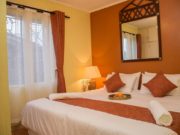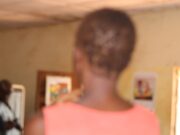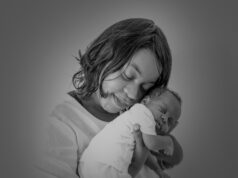Ann Wanjiku is mother to an eight-month old son. Born and raised in Kenya, she now lives in Germany with her husband and child. Ann moved to Germany 12 years ago, and offers us insights about raising her child in her new country, the differences in culture and the unique experiences that she continues to enjoy everyday.
In her last post which you can read here, Ann talked about the moment she found out she was pregnant and what happened thereafter. Today, she talks about her birth experience, including how she preferred to have a natural tear as opposed to an episiotomy. Read on… 
“Pumpkin was born on a cold winter afternoon after more than 12 hours of active labour. As an expectant mother, I had the option of choosing whether to give birth on hospital or to have a home birth. I chose hospital, and one of the requirements for this is that I had to register myself at my hospital of choice around the 34th week of pregnancy. This means I had to do some ‘hospital window shopping’ in advance. I had time to view the labor and recovery wards of some hospitals before making my selection.
After I settled on my hospital of choice, I then needed to make an appointment to discuss what my wishes were for labour… sort of like a birth plan. One thing that I was very clear about is that I didn’t want an episiotomy, instead preferring to tear. An episiotomy is an incision made in the perineum — the tissue between the vaginal opening and the anus — during childbirth. In Germany, episiotomies are not part of the general birthing process and expectant mothers have the right to decide whether to have this procedure done or not. I also let them know that I wanted to have an epidural. An epidural is a common method for pain relief during labor.
During birth classes, expectant mothers are advised to start perineal massage around the 36th week. A perineal massage is believed to reduce the chances of a woman getting an episiotomy, and fewer natural tears.
In Germany, births have been partly medicalised. This means that one can give birth at home or in the hospital. Either way, it is the midwife who delivers the baby. Doctors only step incase of emergency like suction births or c-sections. In case of a tear or episiotomy, it is the doctor who stitches up the woman. The doctor comes in just before the baby is born to stitch the mother up and conduct the APGAR test, which rates the baby’s: Appearance (skin colour), Pulse (heartbeat), Grimace (reflex response), Activity- (muscle tone) and Respiration- (Baby’s breathing).
When an expectant woman arrives at the hospital, she is taken to the labour ward. Moms to-be are encouraged to try different positions during labour, including getting into the bath tub full of warm water for relief if she so chooses. Some women decide to have a water birth right there in the tub. The pregnant woman is particularly discouraged from giving birth while lying on the bed. The midwife asks her to try other positions where gravity can assist, such as sitting on a birthing stool or the squatting position.
Babies are normally not washed after birth unless the amniotic fluid is green, meaning that the baby pooped while in-utero. The reason for not washing the baby is so that the baby has a familiar smell around him. The partner is present during birth and can cut the baby’s cord if he/she wishes.

In Kenya after a woman gives birth, family and friends come and visit her at the hospital. In Germany, this is not a part of the culture. Some couples can decide that they don’t want to have any visitors during their stay at the hospital. This means that these new parents get to bond with their baby without interruption from guests. The mum also gets time to rest without feeling the pressure of having to be presentable to receive guests. Actually this family time is encouraged by the midwives who advises the new mum to receive guests when she is ready. In my case I started receiving guests at home after the second week. And now reflecting back, I think it was a good decision because I was able to get some much needed rest.
Also in contrast to Kenya where you are expected to play host and make sure there is food for the visitors, here they do not expect food. Infact, some of our friends brought meals for me while those who didn’t were contented with a cup of tea or juice.
Here in Germany, the newborns are left with their mothers for bonding. There are no nurseries in the hospitals and babies stay with their parents from the start. The normal hospital stay is 3 days unless there are complications. During this time, the baby continues to be examined and weighed.
On the second day, a hearing test is done to determine if the baby can hear. The baby’s blood is tested to see whether its metabolism is working properly. In addition to that babies are given two oral doses of vitamin K. This is a preventative measure taken because some babies have vitamin K deficiency, which causes internal bleeding. Vitamin K helps the newborn’s blood to clot and stop this bleeding, which can lead to death.
In the recovery ward, after my delivery, the midwife visited me once a day for the entire hospital stay. During these beside visits, she checked my stitches to see how they are healing. She also checked my breasts to ensure that they were not engorged. During my hospital stay, I noticed that for new moms who are not interested in breast feeding or did not have sufficient milk, they were assisted. Such mothers are offered a breast milk pump which they are required to use every four hours, which helps stimulate milk production.
Before being released, the pediatrician will examine the baby and the parents told to schedule an appointment with a pediatrician in their area for further checks and immunizations.
Upon discharge, a midwife accompanies the new mom home. She visits every day during the first 7 days. During these visits, she weighs the newborn, checks her breasts and stitches to evaluate the healing process. The midwife is also there for you incase you have any queries. After the seven days, her visits reduce to once a week until the baby turns 8 weeks. During one of these visits she will show you how to bathe the baby and how to dress it appropriately.
As someone who grew up in a warm place, I had the weakness of dressing the baby too warm, I must confess. And that was my birth experience here. Just a few differences here and there between Kenyan and Germany, but all towards the good journey of motherhood.” Find Mummy Tales on Facebook and Twitter.








































Had I been given a chance, I would have preferred episiotomy to tearing. Luckily, I delivered without needing either of the two.
Lucky for you! I think though if I were to have done a vaginal birth (I had two CS’s) and had to choose between the two, I would have preferred an episiotomy.
[…] “My Birthing Experience in a German Hospital” -Ann Wanjiku […]
Thanks for sharing, I see some similarities with the Canadian system. I got to visit delivery ward during birthing classes with my first babyy and didn’t have to for my second. We also get visits from the community nurse, first one is the day after you get home and two more visits after if needed. I think they come to check on baby, mommy to make sure she is healing well and also the living situation and see if mom has support or no. It can feel intrusive initially but I see how important it is because if home situation is not suitable they can intervene immediately.
I couldn’t breastfeed my first and I had lactation consultant visit me several times which helped a lot.
At the hospital, dad is allowed in the room the all time including in the theatre for c-section. Hubby stayed with me at the hospital the all time, they have a pull out bed for dad in the room, he just had to take care of his own meals. They also have nurseries for mommies that need some rest, we didn’t have to use it but I can see how hard it can be for mom’s that are all by themselves, sleep is very important. My first was an emergenceny csection and I was so exhausted after I slept for two straight days and hubby had to take over.
[…] Also read: “My Birthing Experience in a German Hospital,” by Ann Wanjiku. […]
[…] Related: My Birthing Experience in a German Hospital […]
[…] Also Read: My Birthing Experience in a German Hospital -Ann Wanjiku […]